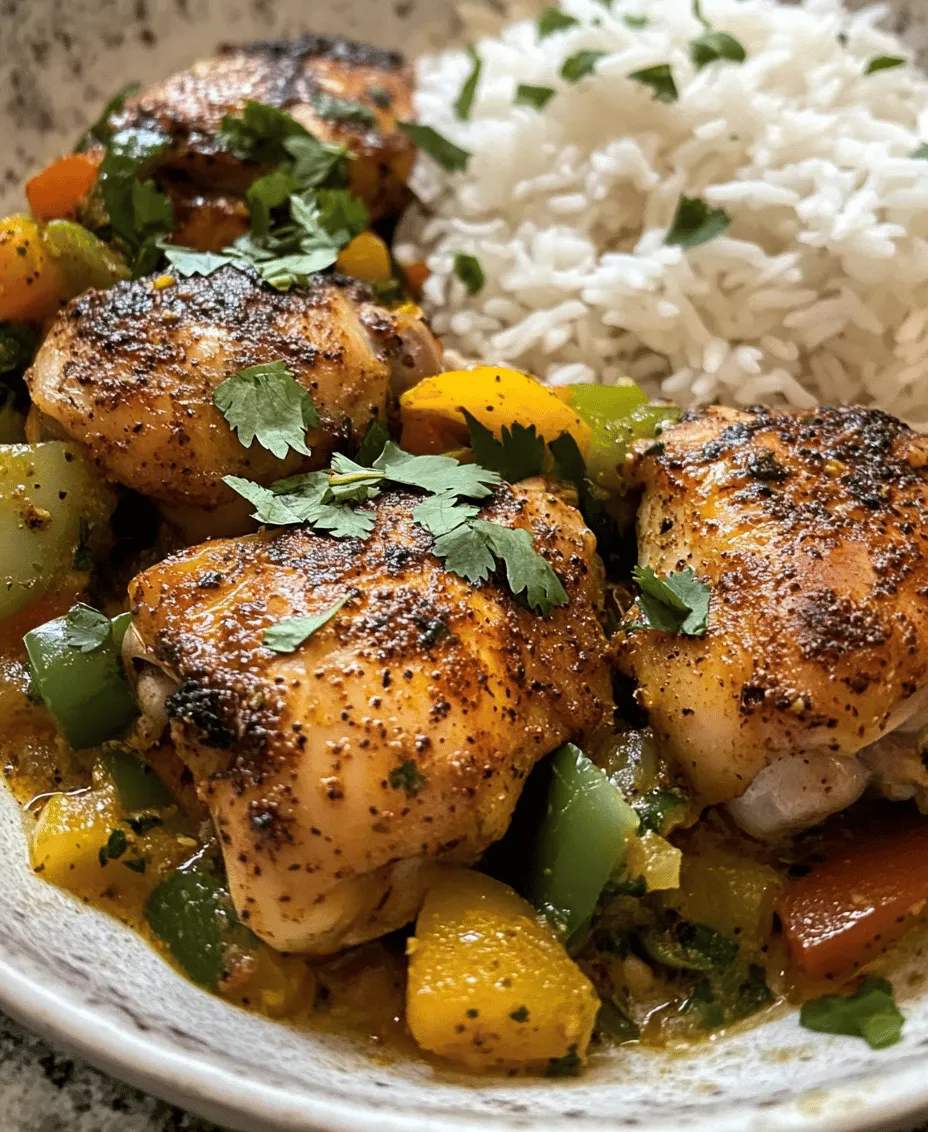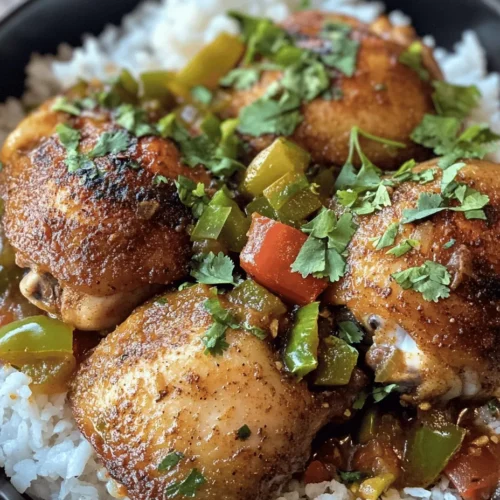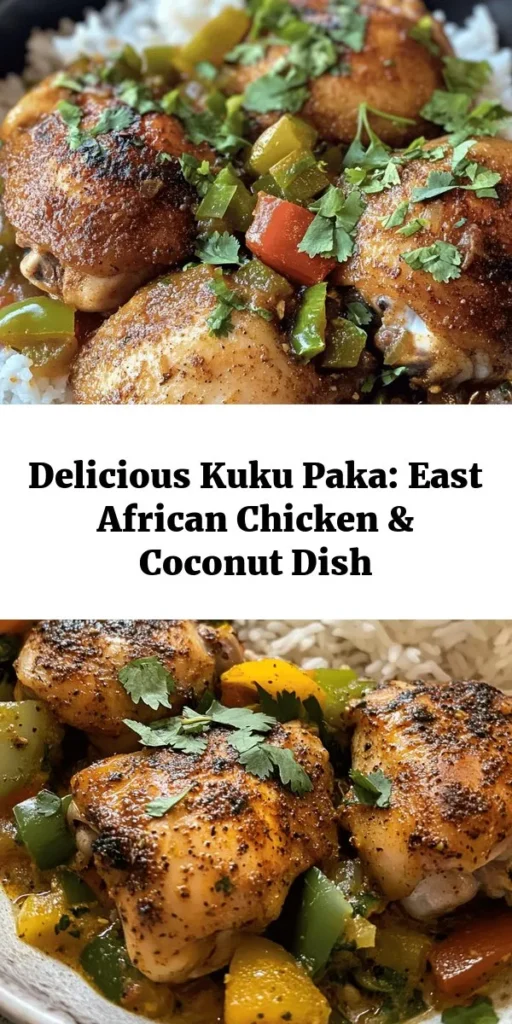Introduction
Kuku Paka is more than just a dish; it is a savory celebration that encapsulates the heart and soul of East African cuisine. Originating primarily from coastal regions such as Kenya and Tanzania, this delectable chicken curry is infused with rich coconut milk and a medley of spices that create an unforgettable flavor experience. Kuku Paka is often served during family gatherings, festive occasions, and communal meals, making it a beloved staple that brings people together.
The use of coconut milk in Kuku Paka is particularly significant, reflecting the tropical climate of East Africa where coconuts thrive. This creamy ingredient not only adds depth to the dish but also balances the spices, resulting in a harmonious blend of flavors that is both comforting and invigorating. The spices commonly used, including turmeric, cumin, and coriander, are integral to East African cooking, contributing to the region’s vibrant culinary tapestry. Kuku Paka’s appeal lies in its versatility; it can be enjoyed with rice, chapati, or ugali, making it a perfect centerpiece for any meal.
Understanding Kuku Paka
Kuku Paka, which translates to “chicken in coconut,” is a dish steeped in cultural significance and tradition. It is often associated with the Swahili-speaking coastal communities of East Africa and has roots that can be traced back centuries. The dish exemplifies the fusion of African, Arab, and Indian culinary influences, showcasing how diverse cultures can blend to create something extraordinary.
Cultural significance is also embedded in the way Kuku Paka is often prepared. It is not just about the food; it is about the gathering of family and friends around the table, sharing stories and laughter. Many families have their own variations and secret ingredients, passed down through generations, making each preparation a unique expression of love and heritage.
Regional variations of Kuku Paka can be found throughout East Africa, with each area adding its own flair. In some regions, you may find the dish spiced with local chilies for an extra kick, while others might incorporate fresh vegetables or herbs that are abundant in the area. The adaptability of Kuku Paka reflects the rich agricultural diversity of the region, allowing cooks to utilize seasonal and local ingredients.
Personal stories often accompany recipes like Kuku Paka, enriching the dish’s legacy. Many people recall childhood memories of watching their parents or grandparents prepare this cherished meal. Whether it was the aroma wafting through the house or the excitement of gathering around the table, Kuku Paka holds a special place in the hearts of many.
Essential Ingredients
Creating a delicious Kuku Paka requires a selection of key ingredients that work in harmony to produce its signature flavor. Each ingredient plays a vital role in the overall profile of the dish, resulting in a complex yet comforting experience for the palate.
Chicken
The star of Kuku Paka is, of course, the chicken. Using bone-in pieces enhances the flavor and provides a richer broth as the dish simmers. Opting for high-quality, fresh chicken is crucial; free-range or organic options are often preferred for their superior taste and texture. When you bite into tender, juicy chicken that’s been marinated and cooked to perfection, you’ll understand why this ingredient is essential.
Coconut Milk
Coconut milk is the soul of Kuku Paka, lending its creamy richness and subtle sweetness to the dish. It acts as a natural thickener, creating a luscious sauce that clings to the chicken and vegetables. When selecting coconut milk, choose a high-quality product with no added preservatives to ensure the best flavor. Alternatively, you can use freshly grated coconut if you have access to it, as it will provide an authentic taste that elevates the dish even further.
Spices
The spice blend is what truly brings Kuku Paka to life. Common spices include turmeric, which gives the dish its golden hue; cumin, which adds earthiness; and coriander, which brings a bright, citrusy note. Freshly ground spices are always preferred for their potency, so consider investing in a spice grinder for the freshest flavors. Additionally, don’t forget the heat; fresh or dried chili peppers can be added to taste, depending on your preference for spice.
Aromatics
Aromatic ingredients like onions, garlic, and ginger form the flavor base of Kuku Paka. Onions add sweetness and depth, while garlic and ginger contribute warmth and complexity. Using fresh aromatics will enhance the overall flavor of the dish, so avoid pre-packaged or processed options.
Vegetables
While the core ingredients are essential, the addition of tomatoes and bell peppers brings brightness and texture to Kuku Paka. Tomatoes help balance the richness of the coconut milk, while bell peppers add a subtle crunch and sweetness. Using ripe, fresh produce will elevate the dish, making it even more enjoyable.
Freshness and Quality
When it comes to cooking Kuku Paka, sourcing fresh and high-quality ingredients is key to achieving the best flavor. Visiting local markets or specialty stores can provide access to fresh produce, spices, and chicken that are often superior to what’s available in mainstream grocery stores. Building relationships with local vendors not only supports the community but also ensures you are using the best ingredients available.
Preparation Steps
Marinating the Chicken
The first step in creating a mouthwatering Kuku Paka is marinating the chicken. This process is crucial for infusing the meat with flavor and ensuring it remains juicy during cooking. Begin by mixing together a marinade that typically includes spices such as turmeric, cumin, and coriander, along with garlic and ginger paste for added depth.
It is recommended to marinate the chicken for at least 30 minutes, but for optimal results, aim for 2 to 4 hours, or even overnight if time allows. The longer the chicken marinates, the more flavorful it will be. Cover the chicken in the marinade and refrigerate it to let the spices penetrate the meat thoroughly. This step is essential for maximizing the dish’s overall flavor.
Sautéing Aromatics
Once the chicken is marinated, it’s time to build the flavor foundation by sautéing the aromatics. Heat a generous amount of oil in a large, heavy-bottomed pot or skillet over medium heat. Add finely chopped onions and sauté until they become translucent and slightly caramelized. This process can take around 5 to 7 minutes, and it’s important not to rush it. The sweetness of the onions will enhance the overall flavor of the Kuku Paka.
Next, add the minced garlic and ginger, stirring them into the mixture. As they cook, the fragrant aroma will fill your kitchen, creating an enticing atmosphere. Sauté the aromatics for an additional 2 to 3 minutes, being careful not to let them burn, as this can lead to bitterness in the dish.
Adding Vegetables
Once the aromatics are beautifully sautéed, it’s time to incorporate the vegetables. Add chopped tomatoes and bell peppers to the pot, stirring to combine with the onion mixture. The tomatoes will begin to break down, creating a sauce that will serve as the base for the Kuku Paka. Allow the mixture to cook for another 5 to 10 minutes, stirring occasionally until the vegetables are soft and the flavors meld together.
This step is essential because the tomatoes will add acidity and brightness to balance the richness of the coconut milk, while the bell peppers provide a delightful crunch. The combination of these vegetables not only enhances the flavor but also adds a pop of color to the dish, making it visually appealing.
As we continue to build on this savory dish, the next steps will include bringing everything together with coconut milk and allowing it to simmer, ensuring that every bite of Kuku Paka is a delicious harmony of flavors. But before we delve into that, ensuring the perfect marination, sautéing, and vegetable preparation will set the stage for a truly exceptional culinary experience.
Stay tuned as we explore the remaining steps to create this iconic East African dish that is sure to impress family and friends alike.

Cooking Tips for Achieving the Right Texture and Flavor Balance
Creating the perfect Kuku Paka requires attention to detail, particularly when it comes to cooking techniques and ingredient balance. Here are essential tips to ensure your dish has the right texture and flavor.
Cooking the Chicken
First and foremost, the chicken is the star of this dish. When preparing Kuku Paka, choose bone-in, skin-on chicken pieces for optimal flavor and moisture retention. If you prefer a lighter version, you can use chicken breasts, but keep in mind that they may dry out more easily during cooking.
Techniques for Browning Chicken Properly
To achieve that desirable golden-brown crust, start by patting the chicken dry with paper towels. This step is crucial as it helps the skin crisp up instead of steaming in the pan. Heat a generous amount of oil in a large skillet or Dutch oven over medium-high heat. Once the oil is hot, carefully add the chicken pieces, skin-side down, ensuring not to overcrowd the pan. Browning the chicken in batches may be necessary. Allow the chicken to cook undisturbed for about 7-10 minutes until the skin is beautifully golden before flipping it over to brown the other side. This technique locks in juices and adds depth to the overall flavor of the dish.
Importance of Cooking Time for Tenderness and Juiciness
Once the chicken is browned, reduce the heat to medium-low and cover the pot. This method allows the chicken to cook through without drying out. The internal temperature should reach 165°F for safe consumption. Cooking times will vary based on the size of the chicken pieces, generally taking about 25-30 minutes. For maximum tenderness, consider marinating the chicken beforehand in a blend of spices and yogurt, allowing the enzymes in the yogurt to tenderize the meat.
Combining with Coconut Milk
Coconut milk is a defining characteristic of Kuku Paka, imparting a rich, creamy texture and tropical flavor to the dish.
The Role of Coconut Milk in Creating a Rich Sauce
Once the chicken is cooked through, it’s time to add the coconut milk. Begin with full-fat coconut milk for the best results. Its richness complements the spices and enhances the overall flavor profile. Pour the coconut milk over the chicken and give it a gentle stir to combine.
Tips for Simmering and Achieving the Ideal Sauce Consistency
To achieve the perfect sauce consistency, bring the mixture to a gentle simmer. Avoid boiling, as aggressive cooking can cause the coconut milk to separate, resulting in a less desirable texture. Allow the sauce to simmer for about 15-20 minutes, letting the flavors meld together while the sauce thickens slightly. If you prefer a thicker sauce, consider simmering it uncovered for the last few minutes to allow for evaporation.
Final Touches
As you near the end of your Kuku Paka preparation, it’s important to ensure that the dish is well-seasoned and visually appealing.
Importance of Checking Seasoning for a Balanced Dish
Before serving, taste the sauce and adjust the seasoning as needed. A sprinkle of salt or a dash of lime juice can elevate the flavors and bring balance to the dish. Remember, the key to a great Kuku Paka is harmony between the spices and the creamy coconut milk.
Suggestions for Garnishing and Presentation
For an appealing presentation, consider garnishing the dish with freshly chopped cilantro or parsley. A sprinkle of red chili flakes can add a pop of color and a hint of heat. Serve the Kuku Paka in a shallow bowl, allowing the rich sauce to pool around the chicken for a visually enticing display.
Serving Suggestions
Kuku Paka pairs beautifully with a variety of sides that complement its rich flavors.
Ideal Accompaniments for Kuku Paka
Traditionally, Kuku Paka is served with basmati rice, which absorbs the luscious sauce and enhances the overall dining experience. The fragrant rice balances the richness of the coconut milk and spices, making each bite delightful.
Explanation of Serving with Basmati Rice and Its Flavor Pairing
Basmati rice, known for its long grains and aromatic quality, is an excellent choice with Kuku Paka. Its subtle nuttiness and fluffy texture create a perfect contrast to the creamy sauce. To prepare the rice, rinse it thoroughly under cold water until the water runs clear. This step removes excess starch, ensuring the rice cooks up light and fluffy. Cook the rice in a pot with water or broth, adding a pinch of salt for flavor.
Ideas for Additional Sides or Condiments that Complement the Dish
In addition to basmati rice, consider serving Kuku Paka with warm naan or chapati to scoop up the sauce. A side of sautéed greens, such as spinach or kale, can provide a nutritious element to the meal. For those who enjoy a bit of tang, a simple cucumber salad dressed with lime juice and a hint of salt can add a refreshing contrast to the dish.
Nutritional Information
Kuku Paka is not only delicious but also packed with nutrients that provide health benefits.
Breakdown of Key Nutrients in Kuku Paka
A typical serving of Kuku Paka contains protein from the chicken, healthy fats from coconut milk, and an array of vitamins and minerals from the spices and herbs used in the recipe. Coconut milk is rich in medium-chain triglycerides (MCTs), which may provide energy and support weight management.
Health Benefits of Ingredients such as Coconut Milk and Spices
In addition to its delectable taste, coconut milk is known for its anti-inflammatory properties and ability to boost heart health. The spices used in Kuku Paka, such as turmeric and ginger, are renowned for their antioxidant and anti-inflammatory effects, helping to support overall wellness.
Discussion on Portion Sizes and Serving Suggestions
When serving Kuku Paka, aim for a portion size of approximately one chicken piece along with ½ cup of rice and a small side salad. This balanced approach ensures a satisfying meal without overindulgence, allowing you to enjoy the rich flavors while maintaining a health-conscious mindset.
Conclusion
Kuku Paka is a comforting and flavorful dish that embodies the essence of East African cuisine. Its rich coconut milk sauce, tender chicken, and aromatic spices create a meal that is both satisfying and indulgent.
This recipe not only showcases the ingredients and techniques unique to East African cooking but also invites you to explore the vibrant culinary traditions of the region. Whether you are a seasoned cook or a beginner in the kitchen, Kuku Paka offers an opportunity to experience the joy of home-cooked meals that bring people together.
As you embark on your culinary journey with Kuku Paka, feel free to share your experiences and any variations you may have tried. Embrace the spirit of East African cuisine, and enjoy the delightful flavors that this dish has to offer.



